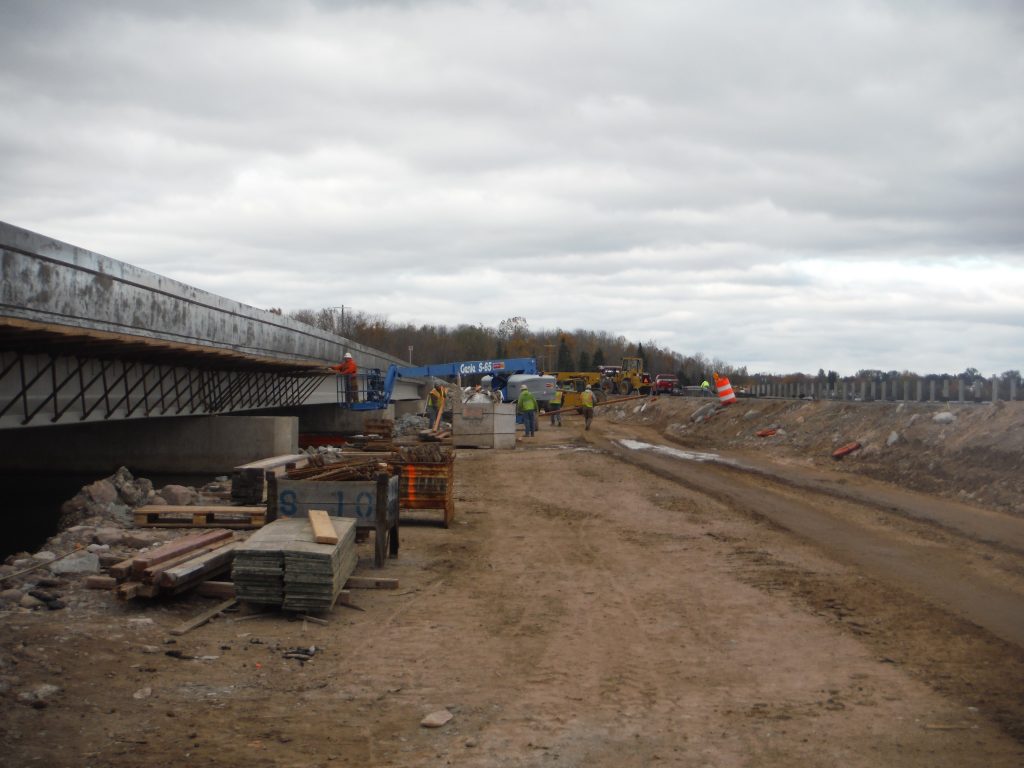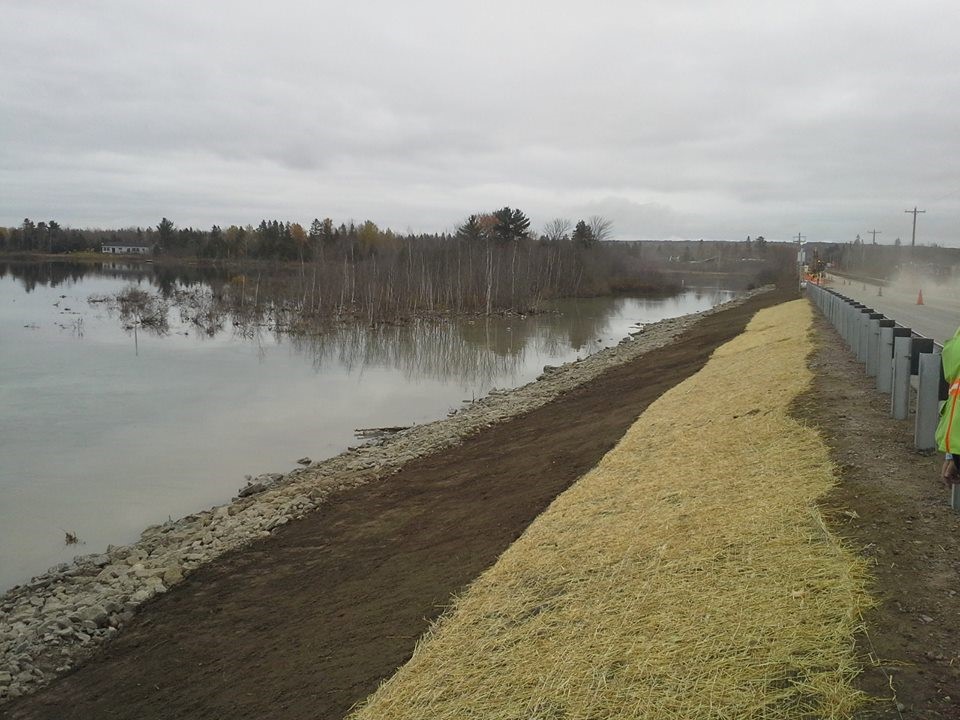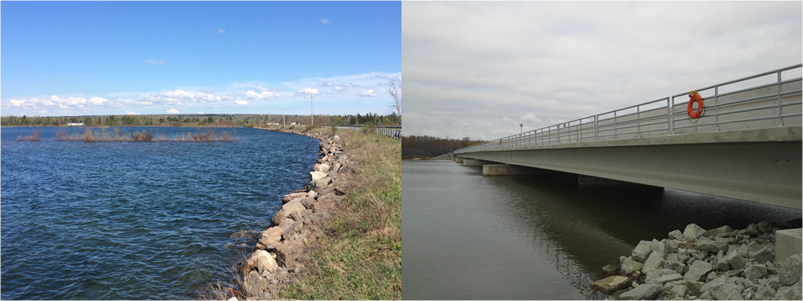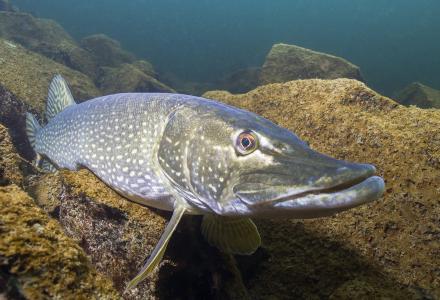
A portion of the St. Marys River has been restored as fish spawning habitat and recreational space, with a new bridge that provides access to Sugar Island. The work has removed one more obstacle toward delisting the river as an Area of Concern (AOC) by Canada and the United States.
The St. Marys River is a binational waterway that connects Lake Superior to Lake Huron between Michigan and Ontario. Following construction of the Soo Locks in the 1850s to help ships traverse the river, pollution and a variety of changes to the river led to it being designated an AOC by the two nations in 1987. That designation tasked the two nations with restoring the river to a healthy state.
The portion of the river known as the “Little Rapids” was degraded when a mile-long causeway was installed in 1865 with only two 6-foot (2 meter) culverts to allow water to continue flowing. Effectively this turned it into more of an embayment with little water movement, degrading what had been an example of rare rapids habitat, according to a fact sheet from the Great Lakes Commission (GLC).
GLC Program Manager Heather Braun says the new bridge restores the flow through the rapids and should provide greatly improved spawning and foraging habitat for walleye, lake sturgeon, lake whitefish, yellow perch, northern pike, cisco, Pacific and Atlantic salmon, along with forage fish such as suckers and minnows and the invertebrates they feed on.
Swift-water rapids habitat historically could be found throughout the St. Marys River, but is now relatively rare. Upwards of 90 percent of this habitat was lost due to past construction activities such as building the Soo Locks and causeways, dredging and urban development, all of which destroyed three of the four St. Marys River rapids. Restoring the rapids has been a priority of a Binational Public Advisory Council which coordinates activities necessary to delist the AOC. Rapids habitat, characterized by high velocity, shallow depth and a rocky substrate provides optimal spawning conditions for critical populations of fish species in the St. Marys River. According to the GLC, of the four original rapids areas on the river, only a portion of the main rapids has continued to serve as habitat, though gate upgrades by the US Army Corps of Engineers are expected to improve those as well.
Around 20 years ago, members of the Soo Area Sportsmen’s Club started talking about improving the fishing in that part of the river, according to Alicia Krouth, engineer with the Chippewa County Road Commission in Michigan. There had been talk of installing fresh culverts that would have improved water flows at the time, but without funding it went nowhere. Over time, the culverts continued to degrade, making it more vital to either replace the culverts or the causeway. Since the culverts were typically submerged, they also were hazardous to people on the water upstream, Krouth said.
“What we had before were two failing and debris-filled culverts that didn’t allow much for flow,” she said. “It acted more like a weir than a free-flowing culvert.”
Fast forwarding to 2013, the GLC received Great Lakes Restoration Initiative funding through a regional partnership with the US National Oceanic and Atmospheric Administration (NOAA) to support habitat restoration in the St. Marys River, said Braun. Other rapids restoration sites along the St. Marys River had been evaluated, she said, but this one was the only feasible site where rapids habitat could be restored.
“In addition to the historic alteration to the natural flow of the river (in the past), the causeway was beginning to fail and the road commission anticipated some improvements were needed over the next several years,” Braun said.

Through the bidding process, Krouth said contractors indicated it would be less expensive to build a bridge rather than construct new culverts large enough to achieve the ideal water flow and repair the causeway in the process. The causeway was originally built to direct water toward the shipping channel, but changes to the river since the 1860s rendered it obsolete.
Thanks to funding from the Great Lakes Restoration Initiative and NOAA by way of the GLC, the Chippewa County Road Commission completed the construction of a bridge to replace the causeway in 2016. About $9.4 million was provided through the GLRI. The work was completed almost entirely within the year, with only some additional paving left to do in 2017.

Lake Superior State University has taken on ecological monitoring duties before, during and after construction and restoration to determine what sort of ecological changes have taken place since the bridge was completed, Braun said. The university is focused on native fish species and invertebrates, the algae didymo (Didymosphenia geminata), which has seen nuisance blooms in the St. Marys River) and invasive species.
Krouth said she’s heard local residents remark on seeing more fish in the water and that fishing has improved this year. More mayflies and other invertebrates integral to the food web have shown up in the Little Rapids area, she added, which also serve as a good indicator of water quality.
Braun said this project was likely the last habitat restoration project needed on the US side of the St. Marys River to remove the “loss of fish and wildlife habitat” beneficial use impairment (BUI) for the river. A draft BUI removal recommendation for the dredging restrictions BUI from Michigan Department of Environmental Quality (DEQ) notes that aside from habitat and dredging, the United States still has to resolve four other BUIs: restrictions in fish and wildlife consumption, fish tumors or other deformities, degradation of benthos, and degradation of fish and wildlife populations.
According to Environment and Climate Change Canada (ECCC), regulatory changes in how industrial wastewater is treated and handled and upgrades at the local municipal wastewater plant have dramatically reduced water quality issues on Canada’s side of the river, along with changes to a local steel mill’s practices. Restoration along the Bar River tributary using trees to reduce sedimentation and improve habitat has been completed, and planning is underway for additional habitat restoration work. ECCC also has been developing a plan alongside Ontario Ministry of the Environment and Climate Change to manage contaminated sediments in the river. ECCC anticipates that all restoration work on the Canadian side of the river should be completed sometime after 2020, said Jon Gee, manager for ECCC’s Great Lakes AOC program.
The latest Michigan DEQ remedial action plan document from 2012 doesn’t estimate how long overall US work will continue. But based on the best information available, the GLC believes the Little Rapids restoration work was the final on-the-ground project required on the US side to delist the St. Marys River Area of Concern.
In a river that has lost upwards of 90 percent of the rapids habitat, Braun said restoring up to 70 acres with the bridge’s completion is a major victory for those rare fish that need it to spawn, and for the river as a whole.
See a presentation below on “Restoring the Little Rapids in the St. Marys River” by Mike Ripley of the Chippewa Ottawa Resource Authority.

Kevin Bunch is a writer-communications specialist at the IJC’s US Section office in Washington, D.C.



